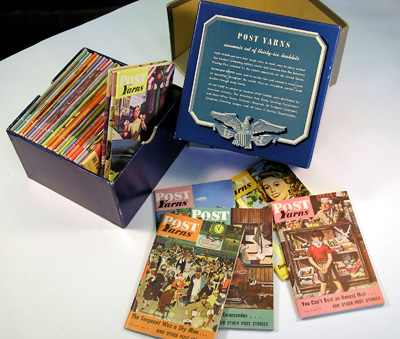In the GI’s Shirt Pocket: Post Yarns
Occasionally, we come across a small treasure in our archives or a forgotten spot in the office building. This was the case recently when we came across a box of over 30 tiny Post Yarns in perfect condition. What are “Post Yarns”? They are tiny magazines, smaller than an index card and 64 pages long. The pocket-size booklets were distributed by American industry, the American Red Cross, chaplains, churches, and other organizations to the tune of 10,000,000 copies to servicemen and women in every zone of operation throughout the world.
The cartoons may be a little corny or considered politically incorrect today (the dangers of women drivers, the problems of cigarette rationing), but they were a treat for soldiers overseas during World War II. Tiny as they were, the booklets contained three selections from the full-sized Saturday Evening Post, a mixture of articles and short stories, which could fit into a uniform shirt pocket. According to the Post editors, these pieces were not condensed articles, or “literary C rations.” By leaving out advertising, the Post was able to get a lot in a tiny package.
Although servicemen referred to them as “dehydrated Posts,” they were immensely grateful for them. “It is seldom that we G.I.’s over here in Burma have the time to write all the letters that we often plan to. However, I must take this moment to tell you how much pleasure is derived from reading these Post Yarns which you are sending overseas to us,” one wrote. “This little booklet is just the answer for a quick snack of reading out in the field after chow or during a few minutes of rest anywhere.” Another wrote, “Recently, a rather battered copy of Post Yarns came into my possession. After reading the three stories it contained, I became quite curious about this excellent publication. I traced back through the fellow who gave it to me as well as I could. I found that eight of my shipmates had read it before me. None of them knew how it got aboard or where it came from.”

“It was a good idea,” the Post editors wrote in 1946, “and we’re proud of our share in it, but there are single letters in our files which would dampen any tendency toward preening. We had a good many letters from uncomplaining men who found the little books especially useful because these readers cannot handle a book requiring two hands.”
Some letters gave pause for other reasons. A paratrooper wrote that he read them “to help relieve the tension” just before making a jump. Another soldier guarding a building noted that they were “easy to carry, easy to read, and easy to hide from the officer of the watch.”
The Saturday Evening Post was happy to report in the June 22, 1946 issue that Post Yarns had gone to press for the last time. “Thousands of its readers,” they cheerfully noted, “no longer are wearing the shirts that the edition was designed for. And they aren’t doing their reading under the special and outlandish conditions which made Post Yarns popular.”